

More times than I can recall, this never ending search for historic/collectable aviation images leads me down a rabbit trail into a whole new world of yesterday. And that’s a good thing because it’s sort of the point of doing this hobby. You’re never too old to learn I guess. I have discovered many new things through such research trips into imagery and the like. Mining the world of black and white and full color Kodachrome has brought me many hours of such gems and nuggets. It’s not always successful, but I get to relax a little and enjoy a distraction from the stuff of life for a bit.
It’s a true bonus then when I can combine history with my other hobby of scale modeling. Such is the case with the Post WWII United States Air Forces in Europe aerobatic display team Skyblazers. I was well aware of their existence and looked forward to building a model or two of aircraft flown by a Skyblazers team. However, I really knew nothing of their history, their personnel, or reason for even existing. Like many others I had what I thought was a pretty good working knowledge of the USAF Thunderbirds display team and their history. But who were these other guys over there and their apparently very similar equipment and operating style?
Slowly, over the last several years I kept gathering Skyblazer material – some unpublished and in the wild. I discovered a lot about the Skyblazers. And just how far behind the times I am. There is a ton of reference material already out there. Blogs and websites, galleries and timelines, magazines and books. The more I looked, the more I found. The same was turning out to be true over on the modeling side as well. Kits and decal sheets popped up that I knew nothing about. What I want to do with this entry is combine a little Skyblazer history with what is out there in 1/48 scale for the plastic modeler. I will not try to run down the entire who, what, and where of the Skyblazers as that is most readily available out there already and in quality and quantity. I’ve summarized the info into a snapshot of both the team and the modeling material out there. The team and aircraft images I post here are from my own collection or as otherwise noted.
Those amazing men and their flying machines
What you see above is an original photo of the original pilots who were there at the formation of the team in 1949. The reverse side of the photo shows their names as they are left to right in the photo. Harry Evans is the team lead and is at least partly credited with the founding of the aerobatic team. You are not seeing double. Well, you are actually. The Pattillo brothers are real twins flying the right and left wing. More on them and their historic endeavors below. In the beginning, the team consisted of only these three pilots. Lawrence Damewood was added shortly after to fill the slot position. The photo was taken at the August 1952 Detroit airshow. A rare non European appearance for the Skyblazers as USAFE had tasked the 36th Fighter Wing at Furstenfeldbruk, Germany with creating the team to fly demonstrations in Europe and North Africa for PR and morale building with service personnel. Through several parent units, aircraft and personnel changes, the Skyblazers continued to do just that up until disbandment in 1962.
Timeline as I have pieced it together:
Early 1949 – Evans, Bill and Buck Pattillo flying with the 22nd Fighter Squadron, 36th Fighter Wing form the team from an idea while flying together in Lockheed F-80B aircraft.
May 1949 – USAFE sanctions the 36th FW with the task of formally creating the Skyblazers aerobatic team.
Oct. 1949 – First public demonstration at RAF Gutersloh, Germany. Soon after Damewood is added as fourth pilot.
Jan. 20, 1950 – 36th Fighter Wing converts to Fighter Bomber Wing and switches to F-84E-10.
July 1952 – 36th FBW leaves Germany for the US and is replaced with the 86th Fighter Wing, taking over the Skyblazers mission and transitions to F-84E-30 aircraft.
August 1952 – Detroit, Michigan Airshow as noted above. The team borrowed 4 repainted F-84G-5-RE Thunderjets from the 27th Fighter Escort Wing at Bergstrom AFB, Texas for the airshow. The paint resembled the F-84E-10 they flew in Europe.
1953 – The Twins, Bill and Buck Patillo, leave for Luke AFB, Arizona and Air Training Command’s 3600th Combat Crew Training Group which resulted in some upstart newby wannabe flight demonstration squadron known as the Thunderbirds and become part of that organization’s first ever team, flying the same right and left wing positions that they did with the Skyblazers. An astounding legacy if you ask me, and one that I did not know until I started all this digging into the history of that other team over there.
Oct. 1953 – 48th FBW takes over control of the Skyblazers, transitioning to the F-84G-26-RE at Chaumont, France.
May 1954 – Skyblazers transition to the F-86F-35 aircraft w/red & white scheme
1955 – F-86F-35 aircraft painted in red, white, blue scheme. One of the best looking paint jobs of any aerobatic team in my opinion.
1956 – 36th FW returns to Germany and control over the Skyblazers as well as moves to Bitburg, Germany and transitions to the F-100C aircraft. Two slightly different paint schemes exist with similarities to the Thunderbirds paint.
1962 – Disbanded when it is determined that the team is now superfluous since the USAF Thunderbirds have air refueling capability allowing overseas tours.
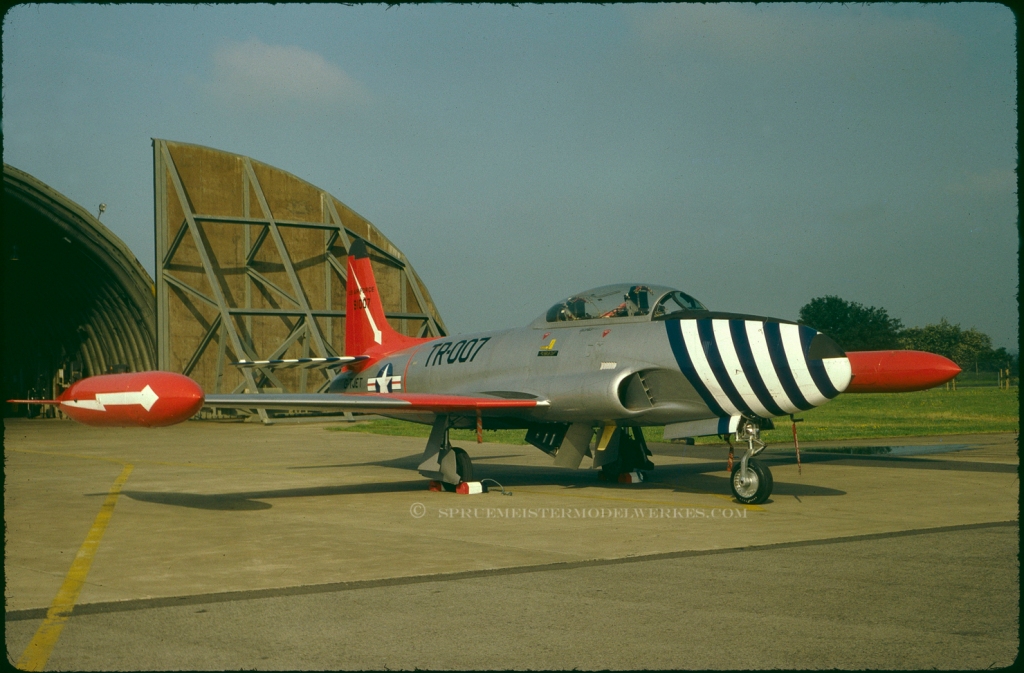


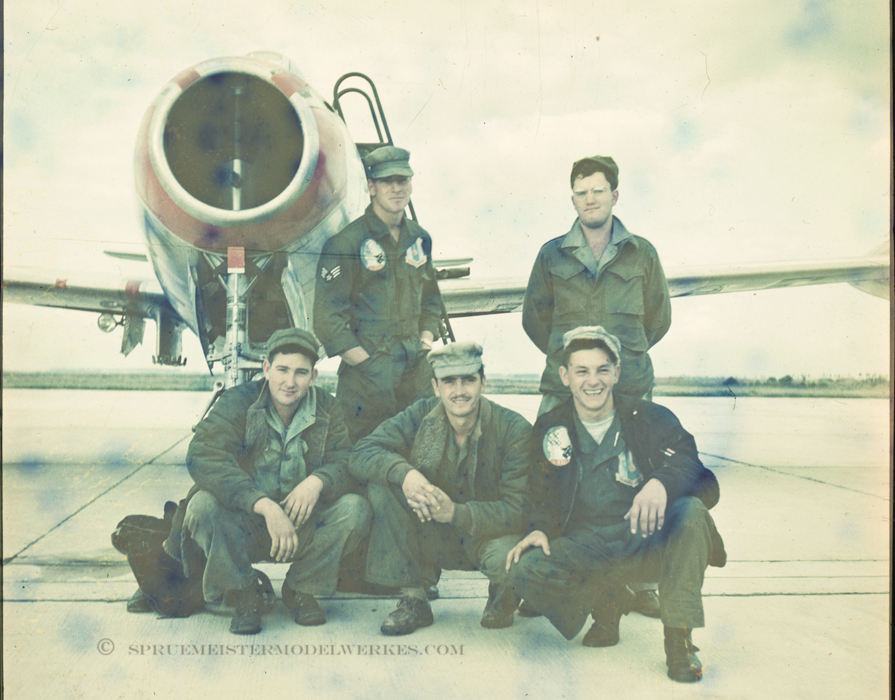
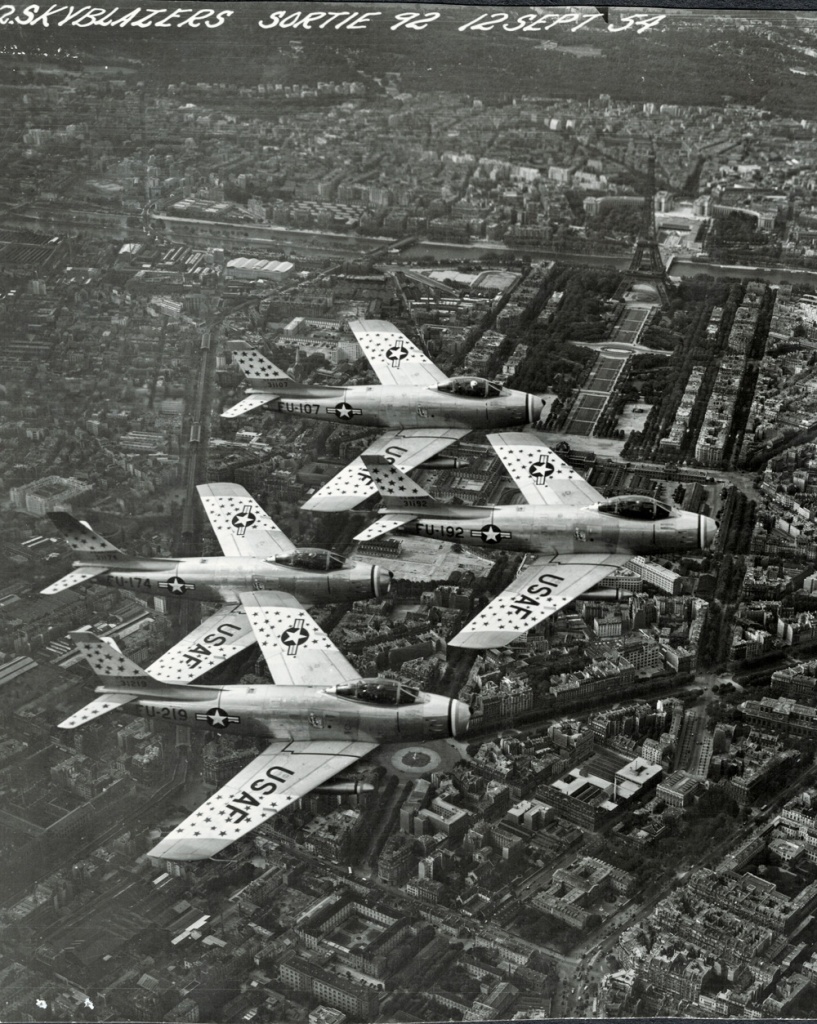






F-100C Diamond over Le Bourget, Paris-June 1957. (Assoc. Press London)
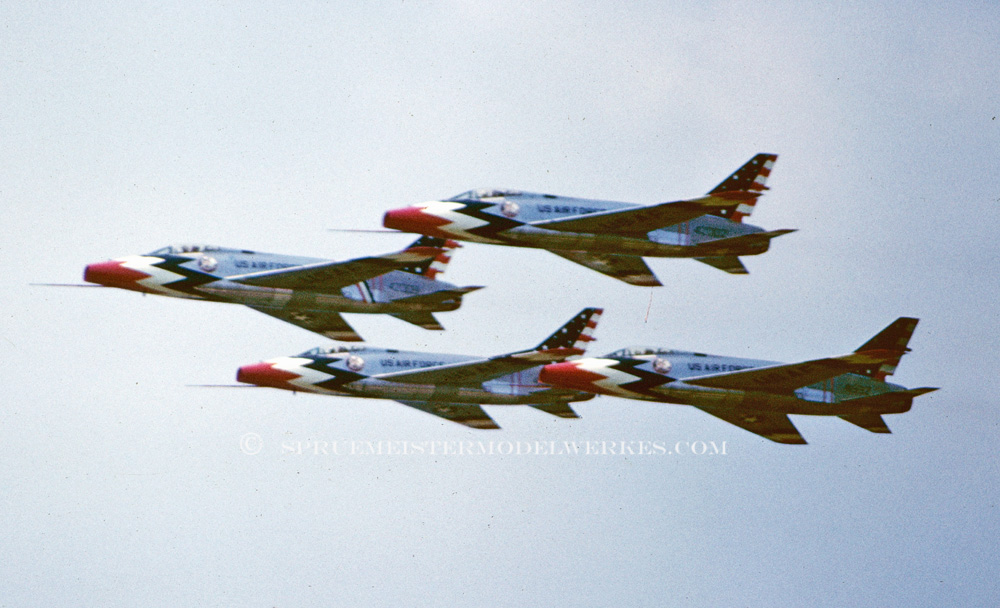
Modeling the Skyblazers in 1/48 scale
Now before we get too far into this section, a few comments: The following is not necessarily a perfectly comprehensive treatise on the 1/48th kits and decals out there related to modeling the Skyblazers aircraft. The known serial numbers as listed are numbers verified by me from photos, either on the web, publications, or from my collection. It represents as much intel as I have gathered over the years and there may be a few I have missed. And there is good news and bad news. Good news in that it is possible to assemble a pretty nice set of Skyblazer models in a collection. Bad news is that some of what used to be out there… used to be out there. Some good stuff has come and gone. Such is the way of things in the plastic model world and it is no different with this subject. We will deal with it as it comes up. The second hand market has yielded a few goodies for me, so there is always hope for those with the will and the time. And before our friends in the 1/72 scale community ask the inevitable; no I don’t have plans as of now to produce a similar work for their preference. 1/48th is what I predominantly work in. I have nothing against 1/72 as I occasionally build in that scale as well, just much less frequently. I just don’t have as much knowledge of the Skyblazer items available in 1/72. I won’t comment on that anymore with this one exception. If you have seen the Mistercraft F-84G kit for sale, it is a complete work of fiction. The kit is marketed in the late F-86F red/white/blue markings, even using an F-86F serial number on the tail. It’s attractive. Just no place for it in the Skyblazers lineage.
Hardware
Lockheed F-80B 1949: Standard 22nd FS markings with the Skyblazers name in dark blue outlined in white on either side of the nose.
Known serial #s. 45-8663, 45-8683, 45-8697.
What’s out there: Well you have a lot of work to do. First you need a kit. You have two choices of starting points for that. 1-Monogram, which is a solid F-80C and would require modifications to represent the subtle differences of the earlier B variant. 2-Hobby Boss. They issued both an A and a C kit which are identical in parts as they are both a C. Again, you have to back date to a B. And accept that it’s a Hobby Boss and not a Monogram kit. You’re tolerance may vary. Next you need decals. 1-Pray that one of the newer decal companies gets the bug and produces a set. 2-Hope that you can find a set of print-on -demand decals made by JBOT Decals which won’t be easy since the owner shut it down with no intention of ever resuming production. 3-Buy this Monogram kit issued in 1991 and just learn to live with the horrible incorrect baby blue Skyblazers logo. I…. can’t. The blue on the entire sheet should match the blue of the insignia so something went really not right in the art department at Monogram that Friday.


4-Print your own decals in dark blue with white surround if you are savy. I… am not.
Republic F-84E-10 1950: 6 blue/white striped tails, 3 digit FS buzz numbers on nose. Standard 36th FBW line scheme.
Known serial#s. 49-2225, 49-2229, 49-2233, 49-2234
What’s out there: You’re in luck. The Revell F-84E is still quite often found reasonably priced via auction sites, club auctions, show vendor tables, and even buried in your own stash where you forgot it after it was issued in 2001. Made you look. The Revell kit also gives you the correct slotted air brake.

For decals you will need Experts Choice sheet 48-53 which is still available through bare-metal.com and a bargain considering that it gives you all three of the F-84 schemes for the Skybazers.


The sheet is sized for the Revell kit and I used a color photo copy to cut out the vertical and horizontal stabilizer decals to verify that they fit the kit almost perfectly. I imagine it may be necessary to touch up the stripes with paint around the leading edges. It allows you to do 49-2233. A second option is Eagle Strike decal sheet 48-214 which can still be found. This will give you the markings to do 49-2229. The sheet is recommended for the Tamiya kit, but that would leave you with the incorrect features of the G model including the aux. air inlets and perforated air brake.

This is almost as easy as it gets for a Skyblazers build. Nearly the complete opposite of the F-80B.
Republic F-84E-30 1951: Detroit Airshow August 1952. 7 stripe blue/white tails, UNITED STATES AIR FORCE title on both sides of the nose.
Known serial#s. 51-1065 I cannot find any other serials belonging to the four aircraft borrowed from the 27th FEW for the show.
What’s out there: Revell F-84E kit again. Experts Choice sheet 48-53 again has the airshow markings.
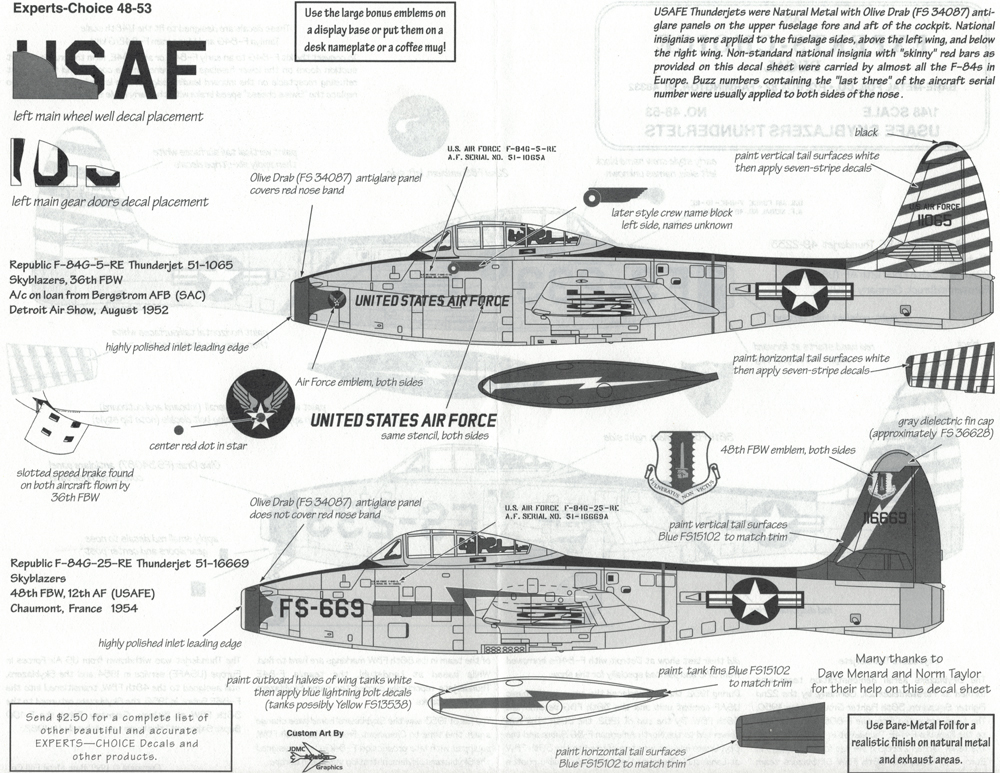
F-84E-30-RE 1952: Post Pattillo Brothers. 86th FBW. Very plain markings not produced by any decal company. 4 digit black serials on tail with U.S. AIR FORCE and 3 digit FS buzz numbers on forward fuselage sides. One photo out there shows SKYBLAZERS on the outboard of aluminum tip tank in black block stencil style letters.
Known serial#s. 51-581, 51-624, 51-626, 51-648
What’s out there: Revell F-84E kit, but you’ll have to go to the spares collection to for numbers and letters to do this often overlooked short term team aircraft.
F-84G-26-RE 1953: Blue tail, white lightning bolt. Tip tanks white on outboard half with blue lightning bolt. Inboard half is aluminum. Straight up 48th FBW line scheme.
Known serial#s. 51-1203, 51-11651, 51-16654, 51-16669, 51-16672,
What’s out there: Tamiya kit (61060 or 61077, the chrome plated Thunderbirds boxing), or the Monogram Pro Modeler edition. With none of the markings being size critical for fit in this scheme, The Experts Choice decal sheet above will give no problems with either kit choice. Pay attention to their modeling notes and specific call outs for all three F-84 Skyblazer aircraft. They are very helpful.



F-86F-35-NA 1954: Red/white scheme. The first real dedicated special paint scheme for the Skyblazers.
Known serial#s. 53-1107, 53-1174, 53-1192, 53-1201, 53-1219
What’s out there: The Hasegawa F-86F in numerous boxings. If you happen to be one of the individuals who are fluent in Sabreese and can decipher the many differences in the block numbers and what they mean to modifying kits to a particular correctness, march on. If not, then get one of the Hasegawa F86F-35 kits, build it and live longer. The decals for the early F-86F Skyblazers are being produced by Dekls in Australia and can be ordered direct, or through their store on everybody’s favorite auction site. 48036 gives you markings for the team leader in 1954. Note, the cover sheet misidentifies the subject as an F-86E.
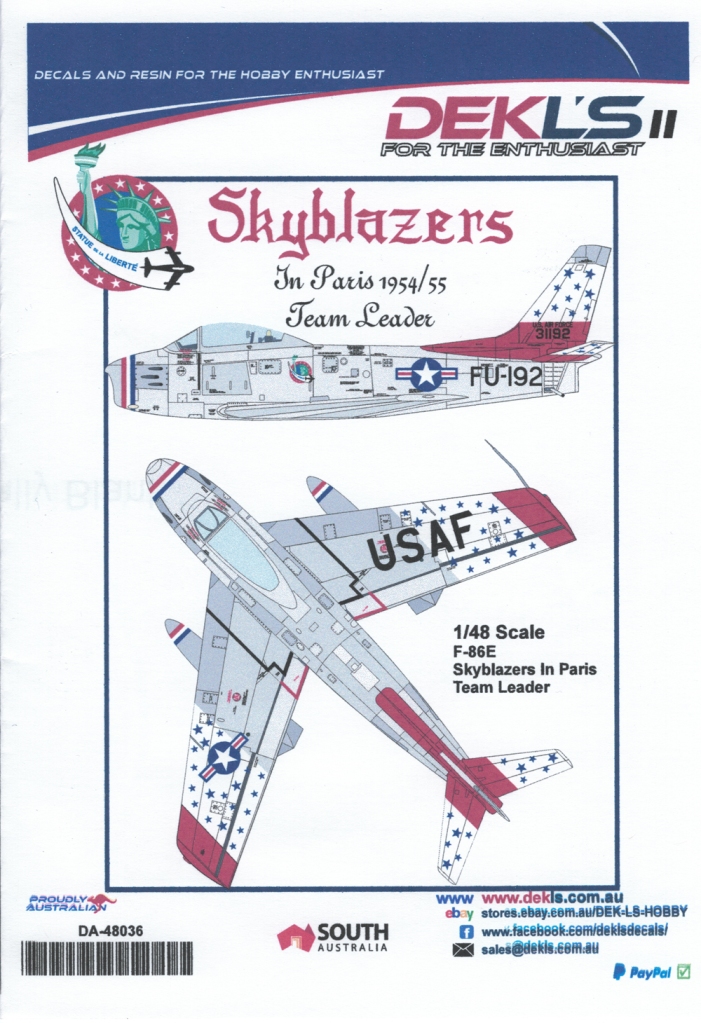
F-86F-35-NA 1955: Red/white/blue scheme. Second dedicated team paint with the Sabre.
Known serial#s. 53-1162, 53-1186, 53-1192, 53-1201, 53-1219
What’s out there: There are two 1/48 Hasegawa kits issued as Skyblazers Sabres; 7076 in 1997 and 9969 in 2012. There are kit decal accuracy issues with the first edition related to the USAF color and position on the wings which was corrected in the second edition. The second edition kit decals also allow the builder the option of any of the four diamond aircraft along with their variations in star patterns on the horizontal and vertical stabilizers. Very comprehensive and nice to see available. Both now out of production, the cost of acquiring either is a getting steep. If you have, or can get hands on any Hasegawa F-86F-35 kit you could forge ahead to a late Skyblazer Sabre if you are also fortunate enough to have the out of production Cutting Edge decal sheet 48022. It does pop up from time to time.

Again, there are variations in the over and under wing markings, so check photos.
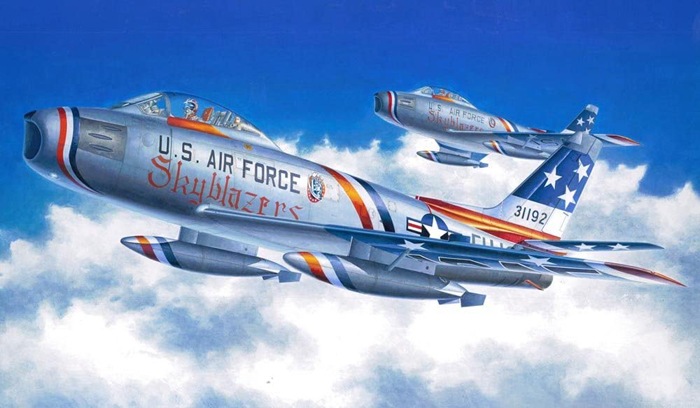

The Italeri Job. There is another Sabre kit available in Skyblazers colors out of the box in 1/48 scale. The kit from Italeri will suffice in a serious pinch, but the base kit traces its lineage back to the ESCI Sabre kit of 1979. Time has moved on. The ESCI kit has not, being somewhat an E model Sabre and having shape issues in a few areas. There are nice looking builds out there of the Italeri kit and it is more readily available, but I personally would choose the more up to date Hasegawa kit and it’s more accurate rendering of this scheme’s markings.
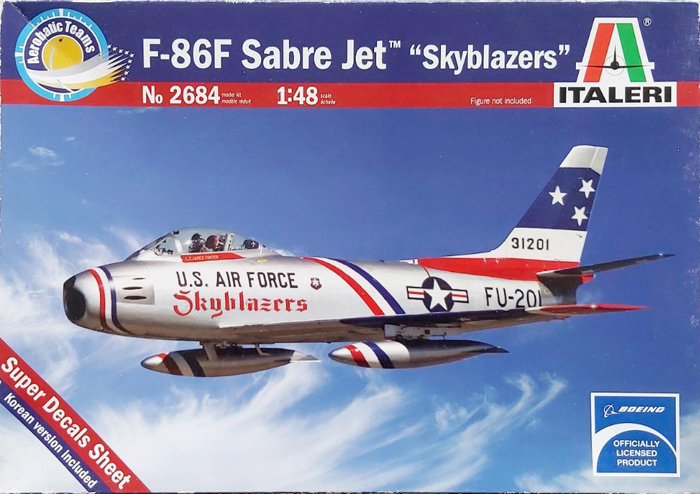
Microscale sheet 48-0028. There is one more decal sheet dealing with the red/white/blue Sabre scheme but it is of the same vintage as the Italeri kit, and truth be told it was probably scaled to fit the ESCI kit. Doesn’t really matter, the sheet has poor print resolution typical of the era, and is very incomplete. There are no national insignia, or over/under wing markings. Perhaps it would be useful for the serial and FU buzz number for 53-1162 which it contains but that’s about it for its usefulness. If it would hold together.
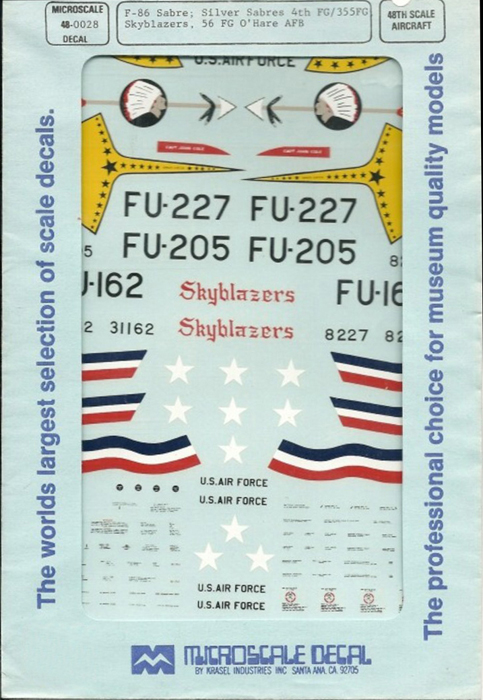
F-100C-20-NA 1956-62: Red/white/blue schemes.
Known serial#s. 54-1891, 54-1959, 54-1980, 54-2002, 54-2009, 54-2010
What’s out there: This is relatively simple, but like almost everything else in modeling the Skyblazers, not necessarily straight forward. You need the Trumpeter F-100C kit 02838. And you need TwoBobs Decals sheet 48-208. The TwoBobs sheet is worth it for the near full color gold mine reference sheet alone and should be part of your Skyblazers reference library. The markings cover both the more common scheme with the stars on the vertical, and the much less seen, shorter lived scheme with red/white/blue stripes on the vertical. Their instructions list the Trumpeter kit for use with the sheet. The Trumpeter kit is still listed by some retailers, but the TwoBobs sheet is listed as Sold Out on their website as of this writing. It can usually be found second hand without too much trouble. This gets you all you need for the F-100C in the last years of the team before disbandment.


But what about……… this:
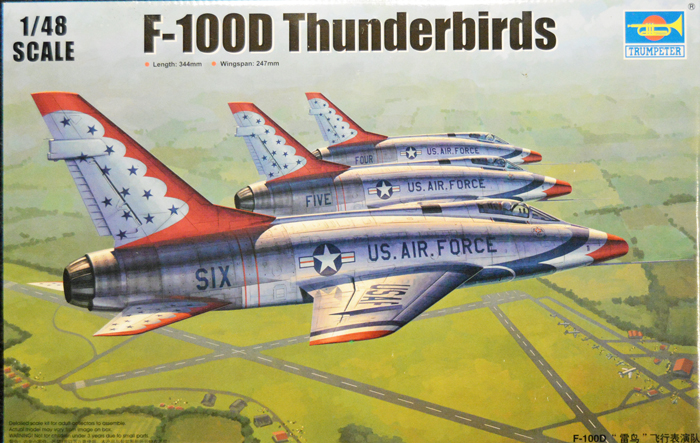
My experience with Trumpeter is that they are what they are and sometime you just can’t explain it. So it is with kit 02822, an F-100D which is an aircraft that the Skyblazers never flew. Marketed as the Thunderbirds F-100D boxing, the kit also contains a decal sheet for the Skyblazers F-100C aircraft. However, those decals are sized for that D model kit, 02822. Using the 1:1 color copy method of checking decal fit shows that these marking are not going to work on the C kit, 2838. The smaller C vertical tail and differing wing tips as well make this combo a no go. Build it as a Thunderbird, but not a Skyblazer. Go figure. Now if for some reason you aren’t able to procure a Trumpeter F-100C kit AND you’re swimming in 1/48 Monogram F-100D kits AND your stash just happens to hold one of these conversions:

You’re good to go. It is not easy to find, and no you can’t have mine. Just thought I’d mention the long way round in case it helps somebody. A photo copy of the TwoBobs decals shows that their fit to the CE conversion set is meh, being a bit oversized which would allow you to trim to fit. Masking the major markings though, would be a better option. Very few modelers will take this route, but there it is.
Epi-blogue
With the approach of the IPMS/USA Nationals next week and its larger than life vendor scene, and if you need a new injection of model mojo on your bench, you might try modeling a Skyblazers aircraft. I can think of no greater tribute to their history and to the men that made it happen. Don’t worry about how long it takes. You may even develop a new skill or two along the way and actually enjoy the journey. I’ve enjoyed the journey of discovery in the research and there definitely will be a kit on my own bench soon. If my personal goal of completing them all ever happens, I promise a full color update to this article. As I mentioned earlier, this may not be a complete listing of what is available out there in 1/48 for Skyblazer material. No attempt has be made to address the myriad of aftermarket items which might be added at the discretion of the builder to enhance any of the previously mentioned kits. You can handle that better than I could here.
Best of luck and enjoy! I hope this has been a helpful overview.
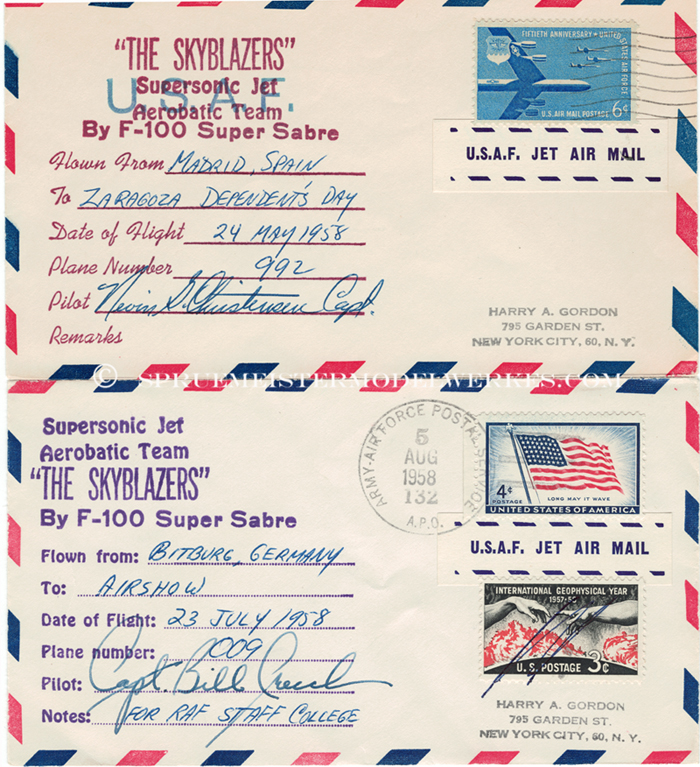
References:
aerobaticteams.net
forgottenjets.warbirdresoursegroup.org
F-84 Thunderjet In Detail V.59; Bert Kinzey
Republic F-84 Thunderjet; David R. McLaren
Diamonds In The Sky; Carol Knotts & Pete Moore
Scale Aviation Modeler International; V5 Issue 01/January 1999 & V6 Issue 10/October 2000
Lockheed P-80/F-80 Shooting Star; David R. McLaren
USAF Europe in Color 1948-1965; Robert Robinson/Squadron Signal
http://tailhooktopics.blogspot.com/2012/02/lockheed-p-80-shooting-star.html

Excellent post, Rick! Which kit makes it the modeling bench first? Andy
LikeLike
Eeny meeny miny don’t know.
Rick
LikeLike
What an awesome recounting of history, many are not that familiar with the Skyblazers or history. My father lead the Skyblazers (Col. William N Dillard) from 52-55 (Dillard, Gilmore, Bennett, Reynolds) and I have his collection of memorabilia and photos. (actually I have the photos above of the F-86’s over Paris) But, saw a few new photos on your page, and R. Lorenz has a wonderful collection. Thank you! I know my father would have enjoyed seeing this. Sincerely, Bill Dillard
LikeLike
Bill,
It is so good to hear from you and thanks for the kind comments! You have a wonderful family legacy from your father from a lesser known flight team. Those Sabres were nothing less than works of art and your Dad was right there! I hope my work has brought it to people’s attention and they learn something from it. Cheers!
LikeLike
This is fabulous! I appreciate all your work. Thank you! I will show this to the rest of the family. We are getting together next week. Just in time. Not sure if any are modelers.
LikeLike
Hello Suzy! Wow, I did not think I would get to make contact with the Pattillo Family. This made my day. Thank you for the kind comments and I am very glad to know you enjoyed the article. Let me know what the family thinks. -Rick Lorenz
LikeLike
Thank you M. R Lorenz to share these wonderful pictures.
LikeLike
Thank you for the kind comment! I enjoyed putting this together for others to see. -Rick Lorenz
LikeLike
VERY interesting Rick, I have never heard of the SKYBLAZERS, even though I was in the USAF 70-74. am very impressed at the detail and depth you went into.
LikeLike
You’re not alone, Buz. Their history is not well known but worth telling.
LikeLike
Rick,
Great stuff. Thanks for keeping the ‘legend’ alive. This is really amazing stuff. This history and detail are awesome. It will fade way, except for your great story.
Scott Pattillo
LikeLike
Scott, thanks for taking the time to read the article. This whole experience has been greatly rewarding and hearing from the Patillo family is just that much more exciting! I may need to think about what is next.
Rick Lorenz
LikeLike
Rick, I just got on Facebook and Suzi Pattillo shared your article and pictures with me. I am Lawrence “Dagwood ” Damewood’s youngest i daughter, my Sister, Rebecca Damewood Wallace and I live in Colorado with her Son, Josh, and his two sons, Josue “LJ” and Julian “Bubba “. We hadn’t seen the picture you shared before, thank you so much! Your article was awesome, we are honored to be part of the Skyblazers history, but even more proud that our Dad flew Slot 1949 – 1952 with the Skyblazers. By the way, our Dad and the Pattillo twins share the same birthday, they were close, dear friends às well as with Harry Evans. We know they are eternally flying up there in the Wild Blue Yonder!
Blessings!
Diane and Becky Damewood
LikeLike
Diane and Becky,
I am thrilled you found the article and that I have had a part in preserving the amazing history of your family. Thank you for letting me know your connection to the Skyblazers team. This is awesome! I never dreamed a silly plastic model builder would be able to shrink the world and bring history and people together in one spot. I have learned that the blog has made the Chamount Air Base Friends facebook page from France, which once hosted the team for a while. Maybe others will see this too and connect. That picture of the original team members Bill, Harry, Buck, and Lawrence is now one of my most prized possessions.
Rick Lorenz
LikeLike